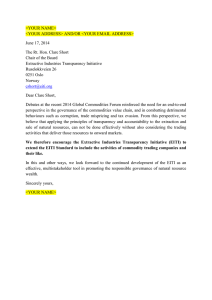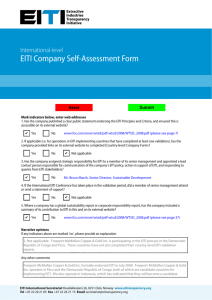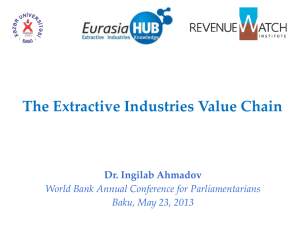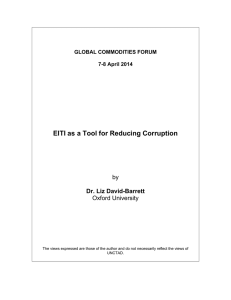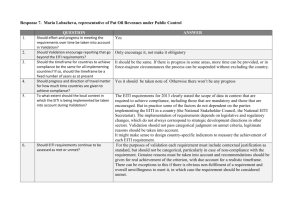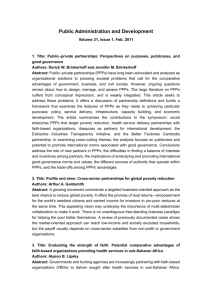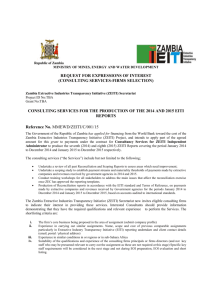Dissemination and Impact of EITI Reports in Peru
advertisement
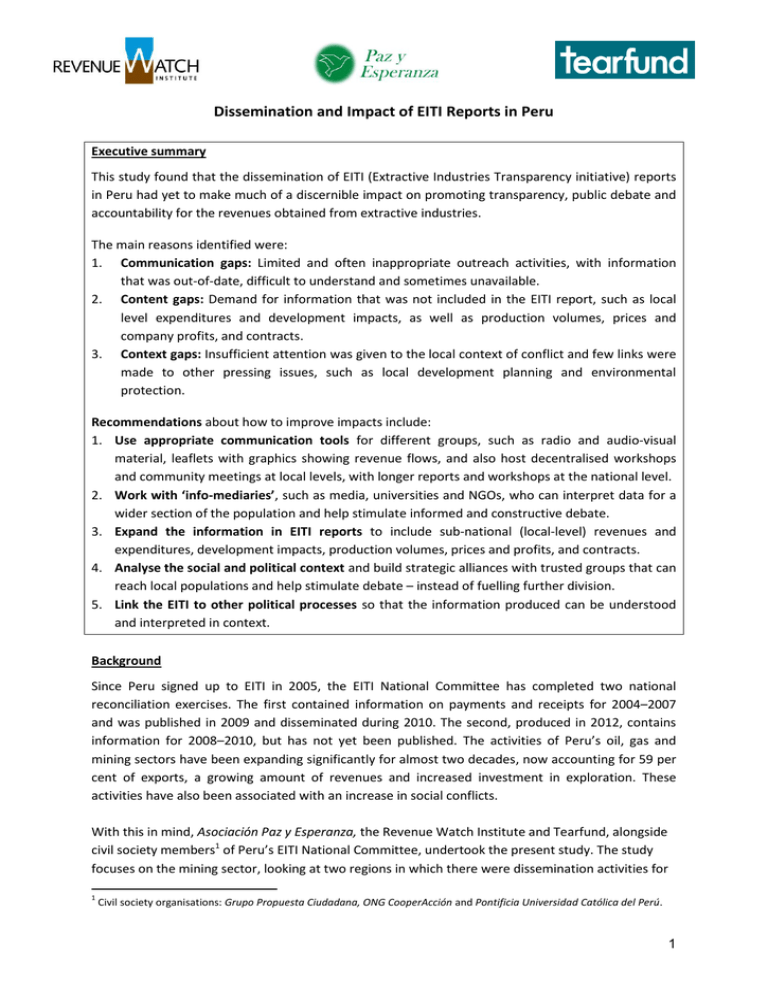
Dissemination and Impact of EITI Reports in Peru Executive summary This study found that the dissemination of EITI (Extractive Industries Transparency initiative) reports in Peru had yet to make much of a discernible impact on promoting transparency, public debate and accountability for the revenues obtained from extractive industries. The main reasons identified were: 1. Communication gaps: Limited and often inappropriate outreach activities, with information that was out-of-date, difficult to understand and sometimes unavailable. 2. Content gaps: Demand for information that was not included in the EITI report, such as local level expenditures and development impacts, as well as production volumes, prices and company profits, and contracts. 3. Context gaps: Insufficient attention was given to the local context of conflict and few links were made to other pressing issues, such as local development planning and environmental protection. Recommendations about how to improve impacts include: 1. Use appropriate communication tools for different groups, such as radio and audio-visual material, leaflets with graphics showing revenue flows, and also host decentralised workshops and community meetings at local levels, with longer reports and workshops at the national level. 2. Work with ‘info-mediaries’, such as media, universities and NGOs, who can interpret data for a wider section of the population and help stimulate informed and constructive debate. 3. Expand the information in EITI reports to include sub-national (local-level) revenues and expenditures, development impacts, production volumes, prices and profits, and contracts. 4. Analyse the social and political context and build strategic alliances with trusted groups that can reach local populations and help stimulate debate – instead of fuelling further division. 5. Link the EITI to other political processes so that the information produced can be understood and interpreted in context. Background Since Peru signed up to EITI in 2005, the EITI National Committee has completed two national reconciliation exercises. The first contained information on payments and receipts for 2004–2007 and was published in 2009 and disseminated during 2010. The second, produced in 2012, contains information for 2008–2010, but has not yet been published. The activities of Peru’s oil, gas and mining sectors have been expanding significantly for almost two decades, now accounting for 59 per cent of exports, a growing amount of revenues and increased investment in exploration. These activities have also been associated with an increase in social conflicts. With this in mind, Asociación Paz y Esperanza, the Revenue Watch Institute and Tearfund, alongside civil society members1 of Peru’s EITI National Committee, undertook the present study. The study focuses on the mining sector, looking at two regions in which there were dissemination activities for 1 Civil society organisations: Grupo Propuesta Ciudadana, ONG CooperAcción and Pontificia Universidad Católica del Perú. 1 the first EITI report: Cajamarca and Cusco. It is based on the opinions of the actors involved in the EITI National Committee, along with representatives of local organisations and grassroots leaders from the areas in question.2 The full report (50 pages) is in Spanish and a longer executive summary is available in English here: http://tilz.tearfund.org/webdocs/Tilz/Research/Summary%20EITI%20Peru%20Feb%202013%20final. pdf. Many of the study’s findings shed light on local expectations around the types of disclosures being considered as part of the new EITI standard, including sub-national reporting, contracts and expenditures information. Main research findings 1. Communication gaps The impact of the EITI communication strategy was limited in Lima, and extremely limited in the regions. Some of the reasons for this low impact included: a) Inadequate outreach for dissemination meetings In Lima, the results were presented at a public meeting at which 115 people were present. Public meetings were also organised in the regional capitals, but there was limited publicity for regional meetings, which had uneven, often poor attendance. The meetings all followed the same format and yet were attempting to reach a fairly diverse audience, often with conflicting agendas and demands for information. b) EITI information was difficult to access and understand Apart from the meetings, the other main outreach activity was the distribution of information leaflets containing a summary of the results and general figures. The main leaflet (No. 4) that reached the communities was considered to be unclear, not particularly user-friendly and even confusing. The reader was left to infer many things that the leaflet could have made clear, such as the relevance of any discrepancy in payments. Furthermore, although the consultancy firm Ernst & Young is mentioned, the leaflet does not specify that the EITI report was prepared independently, under the supervision of the EITI National Committee, which added to confusion. Much information did not reach the communities at all. c) Untimely and out-of-date information The meetings were held in 2010 but focused on information covering 2004–2007. The information was, therefore, considered too dated to create any public debate or interest from the media. Also, more up-to-date and comprehensive information was already available through one of the organizations represented on the National Committee, Grupo Propuesta Ciudadana. 2. Content gaps The information that stakeholders want at the regional and local level is varied, but has a common theme: it needs to be more closely and concretely linked to local realities and to the benefits that 2 Research carried out by María Luisa Burneo in November and December 2012. 2 local populations obtain from the company payments. Although it is clear that some of the demands for information fall outside of EITI’s current objectives in Peru, the initiative runs the risk of lacking credibility, or even of becoming irrelevant, if it does not engage with these demands for information in some way. In particular, information was sought regarding: a) b) c) d) e) f) g) h) Production levels and profits on the resources being extracted. Disaggregated information on the companies’ payments to the state, including for what purpose. Benefits to local communities. How the income generated from the extractive industry is being spent locally and regionally, and what impact it is having. Local-level expenditures broken down by region, province, district and community. As long as the information is provided only in the form of national data – and especially if it is in aggregate form – it will appear distant and even irrelevant or of little use. Independent verification of production levels and prices. People did not always trust the state to provide this information, however, so satisfying this demand poses an additional challenge. Contracts. Mainly an issue raised by those in Lima. Payments to company workers and executives. Wider contextual information, such as how extractive industries work and what payments they make, what benefits communities can expect and what rights they have, and how local development plans connect to mining, oil or gas activities. “The EITI only plays a role of informing and disseminating, but many people ask us what use this reconciliation is if it goes no further than making recommendations. A number of people have asked us what point there is in Peru being a compliant country if this has no impact on conflict resolution.” (Participant in focus group, Cajamarca) 3. Context gaps The lack of analysis of the context and the lack of links with other initiatives severely undermined the potential impact of EITI reports in Peru. a) Lack of understanding of the context In the areas where the extractive industries are present, figures on payments and receipts are not necessarily assumed to be transparent and legitimate simply because they come from a tripartite body, in this case, the EITI Secretariat. This is all the more acute in areas where social conflict is emerging around specific projects, as in Cajamarca and Espinar/Cusco, and where there is clear polarisation of views. This undermines the credibility of the EITI report and of EITI itself, which has been perceived more as a private-sector initiative aimed at improving companies’ images. From this perspective, the EITI’s challenge in the Peruvian context goes beyond simply disseminating the reconciliation results adequately; there is a need to establish a public debate around political issues. A more active presence on the part of reputable universities, as well as local or national media, could significantly help to establish the EITI’s objective and underline its neutrality. 3 b) Limited coordination of EITI with other issues on the social and political agenda The study also revealed a number of local issues that are related, directly or indirectly, to the information provided by the EITI. Examples include the granting of exploration permits and concessions, and issues related to compliance with the socio-environmental standards and criteria established in Environmental Impact Assessments. There was demand for this information in order to understand mining revenues and payments in context, but the EITI report did not include this information, nor did the outreach activities cover these issues. Furthermore, one of the challenges seemed to be a lack of clarity among a wide range of stakeholders about exactly what the EITI could and should do, leading to unrealistic expectations and an unfocused communications strategy. Summary of key recommendations: 1. More effective communication strategy a) Create a mechanism to ensure the provision of up-to-date information. b) Take local contexts into account, designing strategies and materials that are adapted to different groups and that combine the use of radio in the local language with audio-visual and printed materials including graphics, drawings and flowcharts. c) Work with ‘info-mediaries’, such as media, universities and NGOs, who can interpret data for a wider section of the population and help stimulate informed and constructive debate. 2. More relevant content of reports a) Make EITI information more relevant to local people through promoting an understanding of the ‘extractive revenues route’ – where company payments are linked to expenditure at the local level – and impacts on the quality of life locally. b) Include disaggregated and project-level information for all EITI-affiliated companies in the reconciliation report. If not, there is a risk of creating confusion, along with suspicion and mistrust. c) Given that one of the greatest demands for information at regional/local levels relates to the extractive companies’ profits and production levels, these should be included. 3. Consideration of social and political context a) Analyse the social and political context and build strategic alliances with trusted groups that can reach local populations and help stimulate debate. b) Work with different local and regional organisations and institutions as part of the communication strategy, in order to ensure that EITI Peru’s work is integrated into the agendas of existing institutional platforms. c) Supplement the data from the EITI with other kinds of information (e.g. on local government budgets, rights of communities to consultation and benefits from mining, and environmental laws). This can be done by linking EITI to other government departments and existing information sources to enhance the scope of the EITI without diverting from key objectives. For more information, please contact: Graham Gordon, Tearfund (UK): graham.gordon@tearfund.org Erica Westenberg, Revenue Watch Institute (US): ewestenberg@revenuewatch.org Carlos Monge, Revenue Watch Institute (Peru): cmonge@revenuewatch.org Rolando Pérez, Paz y Esperanza (Peru): rperez@pazyesperanza.org 4
